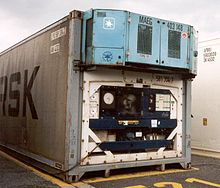Integral container

The integral container consists of the insulated container , the refrigeration system and the controller that also records the data.
Container
The porthole container generation (Conair or also known as insulated container), which is centrally supplied with cold air by the ship, was in use worldwide from 1966 to around 2005 in the north-south trades. Since then, integral refrigerated containers with built-in cargo cooling systems have been used almost exclusively. These refrigerated containers work fully automatically, only a power supply is required for operation.
The insulated containers have been produced exclusively in China since 2007 by only three manufacturers: China International Marine Containers (CIMC), Shanghai Reeferco and Maersk Container Industry (MCI). MCI's factory in Tinglev (Denmark) was shut down at the end of 2006 for cost reasons. In 2007 around 105,000 containers, preferably 40-foot refrigerated containers (205,000 TEU, around 205 million ft³) were produced.
Refrigeration system
The refrigeration system, which consists of the refrigeration system (compressor, condenser, condenser fan, expansion valve, evaporator) and the circulation fan, cools the integral container. The electrically driven compressor draws in the gaseous refrigerant and compresses it. It is then liquefied in the air-cooled condenser and reduced in pressure in the expansion valve depending on the temperature set in the container. The liquid refrigerant flows into the evaporator, where it absorbs the heat required for evaporation from the air. This air is sucked in from the top of the container by the circulating fan, gives off heat in the evaporator (cools down in the process) and flows back into the container at the bottom. The air flows vertically through the load, absorbing heat and is sucked in again by the circulating fan. The air circuit for charge cooling is thus closed.
regulation
The regulation consists of the temperature sensors, the temperature controller (nowadays usually a microprocessor) and the switching and adjusting devices for switching the compressor and the fan on and off. In modern refrigeration systems for integral containers, the compressor speed can be set with frequency converters depending on the required refrigeration capacity. This enables the temperature to be regulated in an energy-saving manner.
On the ships, the integral containers are connected to the on-board network (440 V, 60 Hz) at reefer parking spaces. In larger ports there is an infrastructure with reefer container sockets. For longer land transports by truck, a diesel generator set is attached to the front (diesel clip-on genset).
application
In 2008, around 60% of the intercontinental traded refrigerated cargo of around 80 million tons was transported in integral containers. They are mainly carried by container ships both in the hold and on deck. Modern refrigerated ships transport refrigerated cargo in the hold and also integral refrigerated containers on deck.


